During the month of October, a bevy of luxury brands have taken up the cause of breast cancer awareness, but are these campaigns truly effective?
From donating portions of sales to getting the word out through social campaigns, brands are actively promoting their part in the initiative. However, with so many different campaigns going on, it may be difficult for the participating brands to get noticed in a sea of pink.
"Breast cancer is personal," said Chris Ramey, president of Affluent Insights, Miami, FL. "The numbers are alarming. Most every adult knows someone who has been affected.
"There are times when brands do things because it’s the right thing to do rather than a marketing angle," he said. "Breast cancer awareness month is one of those times.
"Brands contribute to society in many ways. Helping to cure cancer is but another way. Breast cancer is bigger than any brand.
"Sometimes it’s enough to change one person’s life – regardless of whether it’s an employee or customer."
Pink purpose
As is to be expected, perhaps the most likely to attach themselves to the cause are female-focused brands, such as beauty marketers, jewelers and women’s fashion labels.
They are also very likely to have a long history of support.
For instance, the Estée Lauder Companies is continuing its support of breast cancer education and research through a user-generated content hub that shares survivors’ narratives.Manol
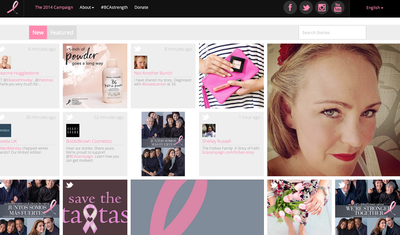
Estée Lauder Co.'s social hub
Founded in 1992, Estée Lauder’s Breast Cancer Awareness campaign and Pink Ribbon initiative is active in more than 70 countries and has raised $53 million dollars with approximately $42 million funding 166 research projects over the last 20 years. Like many brands, Estée Lauder has pledged its support for breast cancer survivors for the month of October to build awareness for the disease.
For its 2014 Breast Cancer Awareness campaign, Estée Lauder created a dedicated Web site focusing on the cause. On the Web site consumers are encouraged to “Hear Our Stories” and “Share Yours” to build a community of women and their families who have been affected by breast cancer as either survivors or those currently undergoing treatment (see story).
Also focusing on sharing stories is Ralph Lauren’s #PinkPonyPromise. The brand is asking consumers to snap a photo of themselves holding a sign telling how they will support the fight against cancer and then post it to Twitter, Instagram or the dedicated Web page.

Ralph Lauren #PinkPonyPromise wall
The Polo Ralph Lauren Foundation is donating $10 to the cause for each photo posted from Oct. 1-31. To further raise awareness for the effort, $1 more will be donated for each friend tagged in a post, up to five additional dollars.
On the dedicated page, consumers can view an aggregated gallery of photos and navigate to the Pink Pony merchandise, from which 25 percent of the purchase price is donated to the beneficiaries, the Ralph Lauren Center for Cancer Care and Prevention and Memorial Sloan Kettering Cancer Center.
Also focusing on social awareness, shoe label Manolo Blahnik turned to Instagram, telling consumers it would donate 10p, or about $.16 per like on a post of a pink ribbon fashioned out of pumps. The post received more than 16,000 likes in one day.
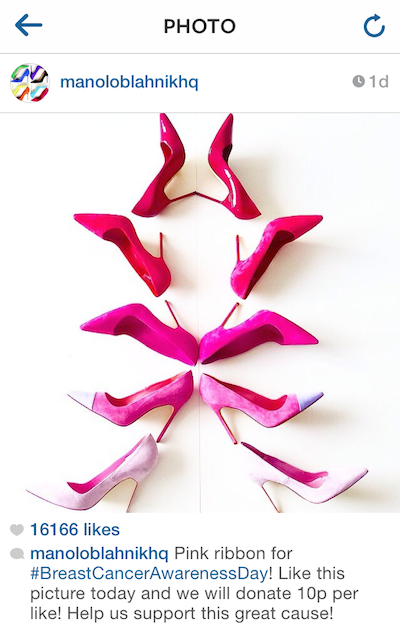
Instagram post from Manolo Blahnik
To raise funds, a number of labels have created special products or ecommerce experiences for the cause.
Marc Jacobs created a limited-edition version of its Honey fragrance, on sale as part of the Pink Shop at Macy’s. From the $76 purchase price, $3 will be donated to charities that work to boost awareness, education and research about breast cancer.
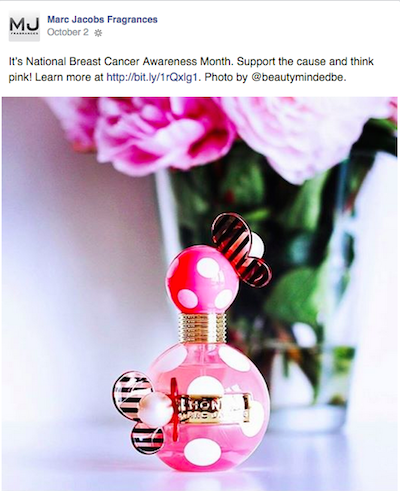
Facebook post from Marc Jacobs Fragrances
Waterford crafted a pink ribbon Christmas ornament, which was promoted by email.

Email from Waterford
For the first time in its seven-year history of supporting the Breast Cancer Research Foundation, David Yurman has set up a curated online shop called “Support a Cure.” Ten percent of the purchase price of these items bought at retailers and online will be donated to the cause.
On the product page, which carries some of the brand’s Starburst collection, as well as pink sapphire encrusted earrings and bracelets, David Yurman educates consumers on the cause, telling them the organization is the only breast cancer or cancer charity to get an A+ rating on Charity Watch.
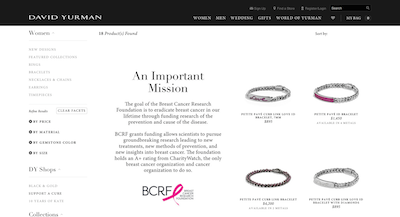
David Yurman Support a Cure ecommerce page
Department store chain Bloomingdale's is hosting a Give Pink, Get More shopping event from Sept. 30 through Nov. 2. Consumers can enroll with a $15 fee that will all benefit The Breast Cancer Research Foundation, The Carey Foundation and The Marisa Acocella Marchetto Foundation.
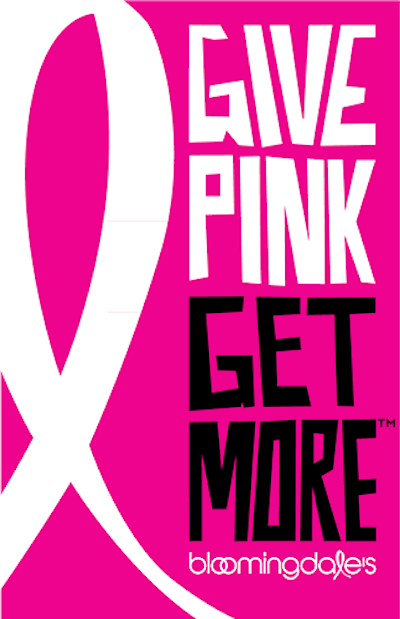
Based on how much they spend, consumers can earn up to a $250 gift card.
Also raising awareness, the retailer has teamed up with cartoonist and author of "Cancer Vixen" Marisa Acocella Marchetto and photographer Bob Carey and his wife Linda Carey, who co-founded the Tutu Project.
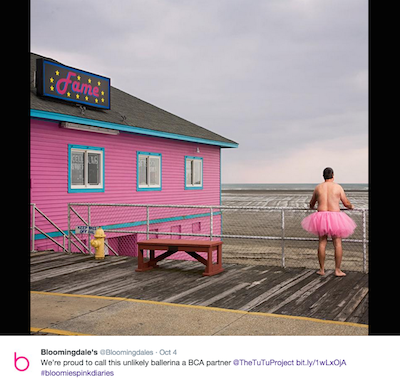
Tweet from Bloomingdale's
Not wanting to be left out, hotel properties are also participating in the awareness month.
For example, The Ritz-Carlton San Francisco is revitalizing its National Breast Cancer Awareness Month activities with a number of offers.
Most ostensibly, the property signaled its commitment to the cause by illuminating its exterior with pink lights. Beyond this display, guests will be able to purchase items that both spread awareness and help fund the Breast Cancer Emergency Fund (see story).
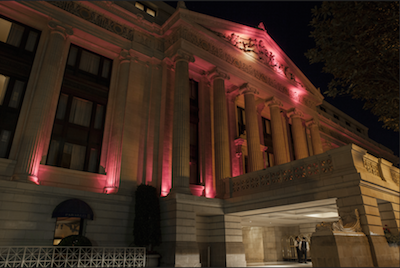
Exterior of Ritz-Carlton San Francisco
The Peninsula, Paris’ pink for a purpose campaign includes a similar pink-hued façade and a Pink Afternoon Tea. A portion of the special tea and each room booking will be given to the ARC, a local cancer research charity.

Pink Afternoon Tea
Throughout the month, the Peninsula’s staff will don a pink ribbon pin on their lapels and the hotel’s lobby and cars will be decorated similarly.
Cause marketing
Charitable efforts have more impact if there is a strong brand tie to the cause.
For instance, Swiss watchmaker Jaeger-LeCoultre is partnering with the Ovarian Cancer National Alliance on a campaign to boost awareness for the disease.
Jaeger-LeCoultre will help raise funds for the organization through in-store events featuring one photographer’s work capturing survivors of the cancer. Since this is a cause that hits close to home for Jaeger-LeCoultre, the brand is not only showing its corporate social responsibility, but also its heart (see story).
However, these efforts may be better at reaching a more aspirational than ultra-affluent segment.
Forty percent of donations from ultra-high-net-worth individuals in the United States goes toward educational causes, according to a report by Wealth-X and Arton Capital.
The report notes that UHNW individuals are focusing on philanthropic initiatives that present long-term solutions to deep-seated problems, such as programs that promote entrepreneurial pursuits. Philanthropists also prefer to have measurement systems in place that can track and assess the cumulative efficacy of donations (see story).
While a good cause, the marketing initiatives might not be the best way to stand out from a marketing perspective.
"First, it's become almost a cartoon of itself," said Rob Frankel, branding expert at marketing consultancy firm Frankel & Anderson, Los Angeles. "It's a politically correct bandwagon that many brands jump on to because there's little downside risk (other than their past leadership scandals or accountability issues).
"Who's going to attack a brand that's ostensibly lending its name to fight breast cancer? Nobody," he said. "So it's safe.
"Second, the pink ribbon is to women what catnip is to cats. Every woman's nightmare automatically draws the attention of 50 percent of the world's population without breaking a sweat.
"[Brands should] not follow the crowd, which in this case, is totally not happening. Everyone is jumping on this bandwagon to the point of the cause becoming mundane."
Final Take
Sarah Jones, editorial assistant on Luxury Daily, New York
{"ct":"3oF5VKba6ngCYt10RC5S4K1LTTWHMc69JLIYVLhwAyem6QjEXYFObxQ4Q4GUDyGbwAI5JHrkknSeo055NFHeNvud+LbLM8Kpjmc7gcLyudFfIHY7y6OegezGytIxz05bXDqnwaUZqDUsc\/btl4fsQ5L0zlraBm3agTwCi9l0oTZp4SyRuW1rtfQmc4bTp548DI5gvTFi3UvMPVqKjw\/ji\/nUDLWCF7Q6pHr7EMB22+j41Wa51EiH6JQmdar\/ZouBBheeeueb6nhh9M5NBo2MOUutX3HKxIUon4eZVnMXFbNKv1TXT4W+ChKY+InWWlnzSbNGqOQoD1NGDA1kMS5S4mLv8JQdmU5J3A8F4JGA1oZjw3HMNLbyAw9VPJoY90qcnEWtWchuGB7PMcx7j3Knsww+ro2aUnGVijGJrmBiyYYDZh0tMixPkqYbfH+cYRr+ZQ4qbF5QhohQ5Gj1Xs\/EE7nyZc5HLhDrFayejtKEU+TeLtObQSIMrFulcc37RzW9rrUc2wavDYbLSzLzaKfXzkcBqHljxBO5\/r2GYjXqx6u2P0kILMvTOhijo5fjq7aUoTzeQFoL0R7Wp1CQOGj0eqAeaSZfypbUcRgWTN0Dxx7RowmbyyJ7svho8WklSq5Q45A1Q5R0XwO+4JIu8s2\/Mo5rBjIZb5jtaF\/rPxdn+0NRiY\/dBPErBBVMJaVrKtW0ynb88P9dY\/OvDoNqT5smRL4psMKy06P0gj7tkWkVLqBwXaHS5wIDklDr2abLub8mKnw81CRMGTcErhy\/uCV7Rdb\/4NQGj2pNaYX0+NGX6XB+8UAme5a6IbEGqVCg\/XHMRnZGfsPVKxmrYR7eHYiB\/M2a0ef\/GlcbhJsJWc9lnaOmcAde5eeFjrww2aYcLw1u0uwAEMWelpKua622dhTBzeZ5yNkZPQlbNj2L3KMXe0BckypKnH+qrUlsV9WQQXrkZd1xBgfbWVL7pQg0gqJthl\/EOeZnaojR9PsBNk6ZxLOpTZmHsXt\/7BSvY+Sts0T7UziZ6369\/2nuADGEQO2bD+0hT2bl0Y4D7\/a3Q\/qL01KnWZ29WtWVTaysI2TU8VPguk0qcW2DlRIXiF74iLikVEpV23f5qf7uvfhhNxCycPa\/FBrRutz2ObE1bUMjgVXAYA9qZduWZcumqxYp0As\/tfBCnmrCXiVroljSvXPSdoyuhOFrhzWDCYVWn7xgqA07nNZOhNvtCJydAQS3L42nLmkwtJZOuz9CQn1c2LyPqv\/7\/HJxfmRxNQjho3wC\/bH77ibR0srhYnc0C9yLl4eE9J7EazmWwf7j\/XsnlJ5u8H8Hx2O53wDbIhElT\/y1CWSiCkdR5OLAmnIy11Yqq2oG9uWTAQlcVpcImi++seEOBBZGwHSfEusJRA0mJzvmePHjpdCkw3V53NgCHAua4PpNNsVpbt6cu\/mvhVffrM4uslJmkYQDkyLAzSbwERS\/G6UPnsoP3NC6SE2Y7ojQVOq26bjzhgSIj9Z1JZ4Ci+1B0meCtq\/aixQfASOgQE3qhMGRu47IL7+99FRkhyRkFm5G4Fx03yojr+9wyPZc2wKr8Rh52GsmRU5HUpWb\/l2caxzx0kFMRgq4zvODU6SeK0D5Q\/Lb5TPVb0u\/jM6MX3QsPpESIsVJ+uwChPdVUVTf0obFt96MRsBKDpw\/3bTvErBKZO1LOOa991dJ5LD2J4rLgQFXRWnT1PIzOtRqMlCWyBi6N9QNXsa6lwqwAlUY8K+Bk3yPNvorix2h+mswCUnQg4ogim01wBK\/ESQxpU6f8QJvEonSMKwu9w2L9aOTyX70nHrnvBciWTgMZ96U9VF1SMaLkrI4ctl6gKaCpuC\/DWNLhYXe4hZd06wgOiftd+kfU+4prkPgASYKkA7gTtcHrfd3haYE1AtHPYYN8ZMTMh1DGP1qR7DNAR82XI1nU1jz+z5aAv\/lnJW52EUI958sNhZKUbw0f\/8TvR4xZPGRaYFk7vEW\/h8JO6M3uEBkswLVAPmvUtgnSgWn3vkOot7MYJtbTP+uvZqx2QsI9jpu2D0m+VamftzoMv5sYMJF7GzkJ3pU9uGBWH+DkBLbfdPS9cq8BOlr0ZM3W05TuZRW3jfv\/nBrLiSdMM6nOBp1ahwxfumAwP+3HMnXSogKgCyYBpbJr3wI38X0CyZjVYMr3mX+LrYm2bPsAqu8KajXofHwlccySEZd3Is\/fAqgDLqwp1VGxcmQI\/\/l+uF2lAqq265+jV3\/Ssvc19gr04WGl1mTljNCnDKaVvYQMIf+LiPSNCC88wmYsq6wbb020XWz5iKCv5wIxZiaDkndeH6BtkAv+OmkiuxX1bxnAL3glVDz2GeSQLbE9FJx5ffoYH4j27qMfsUTjbcKyeBdKHz0g\/Yke99KkHyBtVt8mMCjW30srmySdmYTWve6kPRti9NyDAYvtbITJ50y86iUt6iG9LPEo\/mRNMNEWKrlVns\/A99vmnaFjQ14UBjyOgscxHV4ARqja++F7AQw\/sEDpQkWCR5fK3Pumhbh\/JQhIAaF2\/sqMxzj2XOMIKgBEm\/uNBC8W5IXKweihtVx0Nj\/pkOx08ykrofsoAiKac0uajijj+K12l5atVKDH8ijZILdwbMAfs+lTZihVvv\/+DBJJYmyChmjKXwJ3b4VvOfyT1QE0u3YqkUKoX9hOMS3KzqMY4Njkkfu4sYvc5mWgsrAHJo0vUptiId0M1xGS+XAK2kuP49sOwOh71Dy\/WhLcwU3FumyFUOGW96NbcVp2Gxs0Av1nPH1ldVNZ46Ob5YtnI8HmDoVPxY6MqVh2d5sIZxfwi\/NNu1gIDOG\/KX0VmQc92KpNyC5OLFAlOfgX7FBOeyJeGdhfZtM24Fo3ucbqcmEEaeXmVU0kPPRgDaa0w5jCfPAQm4+J+JFY5qs6\/Go3YFSXCiPXsaUQNlXZWxK7l6aANiufm6oVaVGg+AhKA3TdRUKl9V5DrXNN3KddTcYUha8IzRHpXZdYcAhvGpf6VESLasQ2jX5sqDmh0DEuk7Lyc0bXjqZmi9ZqOv4GXX1\/E1by2+eQqmKh5LjR9sFCaWaS3sME91ASm6Dhk951UFsl2t22lQcjoD8SeByC2p3SQ4PvjW9lRLgc9N9OFsvALk2en3UxIQ9Krzuz1zl7XD6QtlwqerkYze\/Lnz6JR\/LhVFq6PNF\/Pd3Q73x605v5+\/YBPvKMxO0OoOXJdGMv+IUON72py4KkT6Vc9xxdmw10+cO3BaL0wM360+hKVnNc7fNc9WZp3QkB9LFFl4H0yngHkBY4kRAg9pH7qERrnI7s3dDE4Ii+3RLMVnFnrY\/WE6ZucKzYA+2\/gGdJDcRryqrCA\/J0wA+qfkCC\/zggTTHtO+bWTQTYvGBpuqKl1IxxHZC7md\/AZCORTnNFpBwyMgCN30M+zwg7lD5JhsJTONxXIfNHw+BE2nwVp329dPKnUbX2YcMuuRLIeHC0CxMOufk9hKfs6RGJ0Q+DbOx2FX21HlTkLhe1RYkJWhQ17PDteiojmozqIuZLp+xTt6OTq8M4+2T8OmGwi3VWNSIP5jI6BJoFywMg1ZzYPTv96etREsWXaYf8VpN\/Cv5F0vd5G2XUSf9E\/C5EBogFCLd\/h8hr6N+guZCZuoxcb7MGE8uuwWjyX4x0SMUqQsDbisNiD\/ImmRh0vg9qWNfd8za376KpgM1GGX4L+d\/jyAR4+TTzEDA5OPxymqi8GbXZoiNfyGYjFRU+oih0yJMwkd4V0EN962ElpgOCAPwHGk+7mspU4XBHz1G6nLmmL0+aFWZjw38Aq89o+wdrhx2VTf8kNic0j8McvFhjvt2udpgTEjgPM4ekLjTz1Cz43rsJl7n\/PDL7XSWuiN8VFkp5sBFqNcJLgHDhW2gUsXPQ\/yBBlcxh2BlNiMEIvXPyvBpypzaS2owy\/XocDS7Fugv6CpDNQUKR87uQTRNm\/Lf12O7l4xL3\/AuJRy\/HllMEsLsRTx\/PWtTDNhrhY+sDgxpKnGlM\/6eOXuOYksXbSfhLqjUYcG+bfmG+O+qiGSy5d4RlfMjMtlk8LbROReTIIJV+LmoNy9UynFU1V5a8EqasWFyc6Ziact8JmmhOkPnwFB+AgfvDomjIg70j0y+Pk0Tfs8DrurGi5uv1OWZd7FSWHoZ3qqmRwUuO7UWp12GzPTmSHmvk2Jtlo9WXOxWJpStF3d7Pilg2MbMPNr2CkvIvjWm\/YmXUJ7I2Ac\/hopdLyd8\/4Umk0yFpQfkcNlap2XXsRyV4Vt5XHLduXbf0n7+tr7P0J4jYM9VhHyXcquXYq5ZxSidVFE1fmMLN7imtaTUSwJGAIgSAlCuZH+47gwwlsfvL7uMgjYI1dhyUbdKldIRtwRhiHrmvFcLtYmdMUZeYjoLErz1Au31PejPtrgB8aUI95TDxR62mSgiBJqXo98bLfJ3Bm+QCBaprB\/D\/1Arv2UHF6DHHqfVcNJhhRZWC790guPRni6MMvNqi\/7O25zotB+Pq9WXhn8i26ksMXg8NFH2vX3kLpfRxPvY5ilaEr+GY+s5jdxpV8M3n96WqX9AuDfGpEZVImCIYaJrrdOKe38rjAdRm6G4Y+OLoYJfZpp9jjU1hBJ\/Fkk69R+MlXZKMziZk\/03nZaFPAh22JAlbifWLqW+9N1AqQW0LaMoGejQE3iHcXNTMmfPRUawjHrdNQMZf4h5Bwg4LSep2WDbSP9kEr+wxmps4ZRZGY3j15sIo6OmcjLD0wTkRddHWgHSHjJyIuvChOAup4AhtXVHKtx2ww8I+3ZheQlAWKQj12cvclu+bwQGvgqajv6eXDDoHTgwlsEJy\/2I46gi8ajHygR3\/ta5lLu2QuRg7dqn19jS8IebN9OPxcbrAilccxQdsBb8JzfJCqGI996dINFAj+r2IUe4uRAeFMD4XgTs8TwPSKMz9IIBz\/Rvd5R+ALCf+SukT6O7C9\/NxKxziFdy6Gonjc\/aWKANKa3gn8RnF2OYRK8HAJeDoLWfnatPw6ejSSc0BZwDjHl4jwUx56+9DRJEI+2DsJyUxS56UiEA9t08irh84yLyxRrhiLWralF4u+IXvYa1xSYqYUCFFRqj7ZcdFDVQwFW3Y9Z6WFfhHXIC6iUiNs3yWtJxOAQ4cqjujecmJ4duebDv\/EW1UvjOCe7nLG4eHiheyWcpGsBQV\/5ovwremQFOTBWdO19fYuJ+r1gNfwgC07OF3YJr+T\/tdoD0wVhQcq+RkGyVrpBR3I1itPL0OWXWn0dSrAAr7e2RxEWpQcTfD82cuFRb3J9vTNUNCkdijzPUgnymMw4h1s3HXa13d0mt2dsTKnwlrNHvR6ghv0RHpHoXDIhmFkl6Lw6HmqesCSMmTTe5Tb1IKBu6\/WFN0gE6pGACAZC1sFZn3NG+xEReEpNQbZQ5KIU5bz3T74JdSojHlteiLJ28ooBvlA96i3t2H4ttdmN6ui5rXIDe1JfjixwL9DVRiD6cqgSGdvmvDVcPg2FqcOEX6O1hg4wjt8IYuI5faXPCH1MtkttNjLJHjzwAHXLo93hQlEePGELaaiip797NiBWNx0naUVPP26yjzEiw4dKr428we80ykR2NVmYw4T5JFMrWvw+HrSebp0vik4N9t+KMBRxSOSiFvESgDQlu+TyvJipIDd17Fo5NVVj4XbTw8dquAJ8nQdh3iLnyCjVWRbGqZeovicRVZ7S1e4rfQxR4JSF1TX5HMnH+KHvLG4NR\/UW3YDiHpLKzgT4mcSRfiOhXkRFyVAhqFyicuKMuWZrgJfU9tO+gzR\/hUFxPeR2Uv3X7vyEa0uzT3VQcMYXY39BQEHCsyQfJDes7vePi\/bAJfcbWYZ2RRUAb2oh6KbeqEtOBKaE7+twARnMmC5LBpaLA8sR3k4Qq047Z+\/C8o7t2xXi7tK0cYJn0E2UhiPR3u3AK5dnlOyo+KlGbNeJ0S\/3xYfoChcrMOglyhZOCzyAB8iC5b2svSBLeCT8Kdd+mgGjGgPnKSoMY1P\/iV6h6N4Bn2C5Jo\/bDHm9OPJDCbPmsmTo8tW9EfWFfguCraHziCmYMapsS8RSXERdy1RltBw8uo4WyclkeGFA8\/FMme7D9HqpgffFA+W5T3GWzVaaExbyRz2zMxq5MocgZHMHLd1T1ewVw3QRVTgCHSurj7ip5LqOJHSSgqHwj\/tDqP7CozTpTjugpf0OZFs89ctehXc3mBbf1wMhwjh0CiY90cPEyviVgszfmzeAVVffKaXNe\/mqa6DWdm8MHVlkyHlpPXBpqF3fdnJnN+fzQg0Gmv6FRQZbyYSEcg261sxpR1tUpQphl4q1xSy0mOcr5fn4\/d8aoHcENJiUYzxB9s9scwM4tRg4K5pOyH6alUf9A3mAxh6RirfXco+cOTXbXzXyfRfrQyefz3bYqSHiwF\/0U3MJQ6nZ10X3ABBddfja+FZG\/nyQv+D8AnWOjHz5OrxyMwemSESyT4vE5N1bWqJvG6AEy+DQxFKWo3a+MakcZfj9z\/xRYeoMHjbrlzWMbnwVSNBg7zI00inKqsxVo4v3hnOcDkwGbaGx9lnvDUXMrMQe36hhld6KKOAuKCZakjFN8FbJRgnpUBYS5t+g5LfcZzYZQdKg9H3ys5AK\/4m6CVUkrHsa4klBPueJM2TUlLPTAN3rRyLiIhpzsP30gOESRtzAGcYvtQi60si9EUNKfT7MbOovOO23Nk8vl\/TPPZwkGw+kGalMamO59wieTVsvCi28aHD\/NGCXBFAiTk370jYPyD0sjeieOPkT9xq9NPPFZwOj+plj1unvSus\/vjIGDmEeCjo5n1kM+D0sZtGeCJEkfO3gMocgRCpS+\/qaeOIO259WhDcnv3Jge2VDUpxQEV1PWTHyqR5fFpK7ahBe9arxYD5J7WC35V5a2bLjIWTmvXjVGBt8ph9lkkC1SWCQMWRlxoIjs\/z96K1uMqAMLFp4v9FyLN8qUzxcx\/Fs+F3W16bptAfeo3KNIccYVSobvoY1\/mzBjmor6C\/bnQBrDEhL6hyr8rkfJXaPZ\/mp+D8H52ZqWKxAuY1E9VC96tTO9yB9O5KytOCQ+A\/Ri0OnVWcFvZ\/VBdJkoIAwSYqxHBdF1uUg84NtDLmU+Alvtbn3Kki7GsGUjlX2h6Fulud5T+lt6NBM2aAmQaiu3CGdLMNzM86Y1XDPHD2EL7fgpzq0SiTfCbJh\/WOLP6QodVa+GbiCqNmwkHokCJjg7TWB3SEfvBXObmafIRhbtydqvsgx5OBAQcC0LSW\/5qk55kHXIZCDcPmRmfE4IvTd6fKYQ6zmnVUAIzbWXPeYIFNJufTIk5\/rGyL5lEvwe9Xd+mfZiBi\/M9ed2kWnzmmV262KjshBzbqm+e1ixk8h7W4iGXLSkXJ3dBHWBkbbiKsxSK9SFQxBgvJYiZg1d+LwHYmxM6RCnDmQ5K4Kv5qs0TQ6c9VMabqeCjgZ06cvGEKdRsg36AvF9HClhKUiyxQ7kSJq5HgK2I8TM+tdDY00DisQ5Ws5pnajQU7NbTyHC6s+cSei4gdBTrwr5LHLrNbPO0bIvdiA1FDwSkB+\/6S09MGEm0Tgsck3CQeC4XU0Rbm4IDzrpjETXlB1AfghGy2+vJHxmHfziR96u\/TpqhfVpzhM7YFpx0oCjGCgDVPqoqKYTGQsBYGZpC819HkVvq4rOeRxU5DAQ+\/yeu2Nq2nyMlZjk1Qw5DXihCEz9Y8tPAK8UNaR52HmlMsP6f\/NY7pFHwKMp9nE8zoXq7R+zBlOZ\/sxiD8VaJvJC7NGLNW6vYfYT5gysX3UTkAgsCL3hOLaXZyEtZKZEDYErK\/fYcv5yLFbCTjnugks3dHRhyDySCexUKQRdH7JsTK\/dPO0bkWO9sMhDDdK33AnWc8l0WxaQlZ8QQwQbfwOGE3mUTOHjKhpAFMUPGc2FbYucKNbig+cSQgpWpbwYGdcgUvWLLQEaKPRvbfKIQah4+rsE4cnUu1Bjjs3+XFgjQDKkOj\/026yqe6panHl3Si3XZAE0iGhQCavjA5xvudA3gqlsIdjZlIayzZc6tTo4fcL8ulOQFwEy71VOgh9ddg5Zt4C6k6wOZZhqj0UFkD4FOte1hktlwsR\/JSgAjV58wX5ox8qntPGJHtgmgrrroq4kcjXsPM9gyGZ8\/gEg6H9YA3ObvxJ2UakwHe7u0\/4TezIe65IoxgKcqJWJDHj6dfTlK5wQmpbtm+MPXrYBCVqRpoMoOl1V4cZT7HcHhLUzz6y6NNlWkaEHVfIil9L1NEKouWhDLfi9ImJjk6ob9KszrlTPj8YXeJzGScGqOq1+pwch+Z8pxw6ZX2j4OmEMLQ\/j3sxHwDJNNrUKHA1r79qRnWi6CwW71cF1Xm8ga2rp5WrAC2jQT3IvnRFbSOn6X5sa1QSQ7evra1ttMFciViaTLo88zMrnWI0BRhbLHEQYUG90fu8c1kLf04dwJ2a\/f4DtdKkKq1sk3e3qz9V1vchjnUD383TzobfJ8\/U1xR\/WSO+Do706SeZNNm5skY3qIFzQO59gLSlhazy4YPkVGsdD+KrYetsPg4c93rm3FNSDQorYEMshV1iP4yQRE3cw7JtTQR6f13hvGZ6fNucZFL4trr799IaSTKAOtB0xFV+nmt3au\/xX5vdBkpvPdYbxfY\/unZmv7tsvDdSxLryXtUhGQATinxpiqZARHkrOQJHuRU3dGuDU2Gg\/S6enTxcP8kMQDWRy2Rsq9Ks+6nPWtPaio\/gXnLVZXQztxXNOqXa7HzXcDhT9hteCbk9rO+x\/QtK+LiX2bIY98qYjrk3vwsHLlVpWFpY\/VBTV\/O\/9SDXYdDnyAAvDrLwe9IegkxZuWlrKQTNZhSzHXlxOi\/y87PksX\/Ip5kGoRtzzjidz4\/L3tt1y9tii66jhlqzFMiRxUJIyUmZ9riN08BJAhQwi5cnWzJxiV7licyb9n6oNJ+rHTnD3k3FSSvmrWpHZBjuE15zyq2exGIsQF1k7Hf\/ZYOsuxzOnbLps\/c20sjDj9mC9YIYoip028Usefpb3ftI6TY5lpTklZkXuDbn4YYTMNxnljHosmBTc036b+zQRDX56unr9YcIlUQPrQhtaeuDN6vcDfuCPW5hHbXka+74Sh8rWpdQdZn7d+t7FD6CuE69vi3382RECNp5gIX7G1\/7EPXMvb8SYOwfvoIYIovCSWgKfG2Sh93ZEup3oL5xXnQyDOoFkIfdgXyt7xbl9C7jL+eSd0bQOZkyv6339wRHS9XZSNfasdDOVHIboByswT4PlXVNv+epMqPKYA+vh\/ipXhmNgPfrkqJfIBJNl4wWCnxIexObg3jrVYYXsfD33P\/taD3DxVtsEq7OBHMDY3Nzg+HfjMf1GOH9U0n3mnePKyDKLXnSIC28EvvKHhBSFyMTP6s9ahSr0abs34ZCh5goPl8OJKdKI\/v+J1\/Sipi5eUiiXX6wftKyLHXCY7x8u6jBe0wsLdwIFi8\/93oqis6EFjaSuaRFN3kcpPUmbFeXm4u17l399EB3UjjFGrUzBR8haHMkLdfapQiGx0fQxvl10Caa8\/EnkXJMYI57HPVkKwT9IIzRxHvPNeSeSpClXF3TeFz\/TLySdYY7RchIb3ZH1t9M6JzXz9dQc+9Tlg+TCLIsBMqySr\/oLdM8lfVXqeH0KZlCjCPCWAscBfMVnywy3O4tGfbI93Tbhid4w2pji6xHedw8xqrnsPMffgrlWlPpxRVdVdQNzkNxeqjNDXUsQSClQuQ5rbkGoml3DVqNc84RfmU8CTVoWn7JEKBK6vef1lajs6EhrdWATl7UiXMNzMYw1jdjxUTufZAQpjsJ1Hi0+Ko7CEoEckXRi6YlcC9Tw58XwQqZDN8I15IHQMUAPUItPKELgmfUAABcr16rt3spuvYKj08oH1ZPzLFNqDlC03Dmd2HDdsK8z90S2fKsz3jlYhHrqiuRxDYV22lmhnvQ4jm7l3yz26x7iAQQabmE\/weJkZd3nA1+4ZrEVc5UyzyZdWvX93MMSApvB9mJb+\/tZwmoIPTORIrwYiDIvOCngC98dQY3aoHd2m7F1yVAoQGsVxjDwooq\/uRU9snCCtWtYdl\/ThRehsc3tLFIwY\/kS5Q+zBSf9plk4TmotfiDwRxeegmPfqApf5IaErcIkZBTqjfvxyQ0UFVgGGmTy0RkJQQL4A2X2xfkJB7yPKDqDCrpxSNc6OCqCHJT\/wgFWrDWt5CAPh3CLsl4Em0ozFC5flAOf+eugsFj92AC1kk95vJF6fqPtOGQNUkjsRh3zC\/Mkjl7NnVJWZ8juoyerhTT4y4bqNvj0L0WDxC2D\/jE\/BIcFy7lA4\/cOouanRrv2uxwGLFhkTCx\/frLPnYQWTzGOURh7TkAiRARjbUu1ZJqwPMYhOnvlRdX6M75cxJurC1Wk\/iwRrIVvV3vibE9nBTxXdArz3uU6bvBuhmeIuAZMQJD+pWwMg5o0r3T4jPnYRcmtW4rm64pbwjZdY8CAfOyoPijo\/yILNOeZit7Ps+IvriGKfuGJzUFytuZkdWzKCAc3FNSBvhYG497DxnpM8c4vXFGUekUQ33JEygP325Ur7PEIyEAZ4M\/a0Bpn6nVTcTjyO3YkQpgtS+Y+LecQzsDDZe4hlkQF7t\/cnMx6hMTHlf+4SSbj7\/ci+7tBqt+goah15Mwin8hErweSdcFbcxre+xD3pDhIKJZplYOMV7V9Aa+YSrCI9YULzgX6AW9esNiCOj0z\/1LSC\/W5xBbcUvrMPPGcV17lCmqKXa1uoW2IAKuNDA9P3BNl12WXHj6lbNjKKgTcgP3GbMFANyEIeLkzClwZ2ewQV4zXMccJY44MRD4Iyoi0qyIcKxYsoQzbardSyirWEaoHMF9i3J+lsPbSbpmnONl1uh4fwLwU4K+PgwrI+XAWvXkYU5JyVICxKB\/Atu+cBCBlrrmecqRSHpu1dCmmPfpee5Xso7NXgVTBYBWmn7wE\/oTQdObIZFNDm3megqv55jflU0y4P1CGVryKmIhYuWQzv7useVVpQFU5QFC3xyk6OwZybtecBBiTqAccr9XRiDPOt65T\/kwonMD9Etly82Wtzr2w5pZVuunKlGElAuxxxK4EPkGRAtUcLH2RE+jNP\/QMcPWDkT5ft8fjshBs403\/7tO0Rt9PeLF073fk+Cu+Bx3myXuaLn0UrZHGgo5XUOy6TxEpJzVsr2Nw64outN6siCBW\/YmpTJVgEX6bVPU2KvHbMYrFp7QdQhKTG9ELvrGvF6YrAX12+nJ5rX3F44C4Cgyg18nxCI4DVzTpB0ajmnWr8P4uKEEvVLjXPYR8HYoSdvqSV9\/XzaCncZ7dgtJAXGcv7bkrgWwmgnnALLvn5iFxcm1ba0O+hvGCA9VwP4DbvQLZjYFRXMxmmUZlRkdE1R\/WCzuLzLAbkT6sH8l+T6\/G+axW1Cx3neEGGRvwk7xz3H\/H1LizYfvSvHxF0uJe825JU7H\/k+NV8fOFbksi+0XJtbaa+xcFgSMLpjE7G3QGvMnd\/b57uK8+IIdD9Ch8KA\/Qr1ER4xlBp0JfNKEmUgM\/JT5w7LsSYqqGIm6+emAY21IOnIX8yxKz1+dkkTcHx1mIspcpIAsR9YI7aoDqysJBG\/3UkR\/GFlyK6MwTh0U3EJmgkKN25ggIBdnNK7RuEcDH6aXbdSgmLh7EWB8sQ3cN5rSYFcHZ+ebwDo0NGxcBsDa+PtpwQ4ZyST\/DpyOCTZtChRvZBxGcAe1xIcLcdFGI8O3rmYzpXX5en62NIETBhpBzn5dc3IRp6ms+m0lGkGzVVp5kvvPKGv8MmtvnI9ixvbpvrQEhUIDRIq0N8tLX66rOdQDE3J8AMeamJ5EpUXBRioXcR+DVZQIfFDk7DpA3l0uQiP6qwNrqIABh+QFNAMP0m8ip+yr3Z1j5PZupW4fSmRSZzJmnhvicZPHxWcAfXDNJSGENg3O6RNCAQi+Ty+YqvPoTXTSf+gQgkOASRFDSRkvs72vF6BpuwOd7H5BoVu1bb+Dt+vDN9ed4Pgu8\/U+pxyxzhHJHhlYn1IcRB9Tu4ffLpTgvmTINct4XS0ClJjv5wAWqRhsCKVq\/H2sdShOmJRJ6x28Ag8mf9GIAF1KUJjw6s95uC7bCMpZSYFxnW8WmOupg3MvHD5u75kZaZIN9tRzsU\/iMIR0RS\/9nsWnf2EkdL8Ss6TAkwvHpe9\/EPKQdmk1RZXuzDnp1GDAC9KorU\/ZzCWzWteOLNnYW0GY1dQ1JgSIH871BsyhFBe6i\/fyFrFZ4yUe+xFa\/aZRUG\/o32JD0DFmfhpll7fX4CBBx+tn80Bb\/cDY6Mm+CAtMWNoMaj3g8iX7DAlLE9oCN7ohMBMYb+x\/Ncy8PUahg8B7mPgxF7GE\/E+07uZ8KAo2KVsYmZbW3WNw\/GKl3aGyR8de7OtMX4I\/OQCQ3kcuXy1Xp4r93NZHIigGGREHa8U3Ow6ZpY0P827XGgfkauRujnGGtT1oAOYoKHtLYB2VQ15FIue5hxy7PTMXz52ZOP\/jftzOlwS+TurbnZ\/mfJo1fWNxXNRHd3Vu6eRK75+CSUJ9E9LbZveQTxDkezGaW2a8ED\/M7rrbyhK6qy\/NFEsUSzVJjeHVZYEbHYVljBeO5dA9f\/nOpKioOXWqZ08JXQ0M5HSzn1PsIWuRidvSdYhBGY8Rdfntpz50cf72InV27gbV13gXrn1uEB6Uie\/fVolKLsuitHHShnQ1dLpavBiOBSg1yQPqWWKupFF9TTcrkC3QUcAA5aJant5dIp6IfqZwvICGK8ZUAYrtbPaIuJFSIC8SOb7TJV1uer0aP0V0tGmS1ry00O+QXSW3VosNFngz3gBh45cPNYIOnBB78f4RAirLFf0lDOjdLy2Zdiv67BKkkMP3d+Ys9PqWwrRcCBFLsjNkSP4WX0LoyBPCxoZyPswlS3YtUMmXP1Gnkoz4q1K3z+f2z\/g1+TVQa+wvIoMteL7HT4bo3Cakqx\/bVcUTuVMw8g1VDEYXfdywZ5olOERgv4W1yif2EPRg2BX1UquvEb1gVI33l4+Mjd6IRvfWVlZbNIXohTEztl\/kcJktiUpcuKhUvEZDvFymgfB4NqHJo\/Y\/adU5zU1moBsjklVkMhtZ0ZxdxigOrT9DBPHXe3NgJgfc8NWVSFSjWVEZbUDTBcIJC9FXsPElYclMP0tZvH1KXGEr5cxUjckh0LRKNsax5dMTnbWztzeCGJa0I3xLQ3oKqOYSHAL9r5zbWXZyd+QYdBrW\/EF4lYQrB6XVw0dR4TNgypXofnQ6Zrryn8SVbbeVU29ent3jnkQGiVka0DIyOVAc+H4eDwoMUTa8PCDmr1a8z0SWqXLGgfwWuECwUKI3yb4mRn6QHLdC+QhjD3D1cHl7fJLZrF0BhoPZH33qs87iK+ETjCsnlhjCORdh6+8P7m7PJt4kW0p81X7yscA7ShobN75JGLQC+a27PwM1Hf2B58kFmMdgsbwhPyJxwrQlfZswzb97U2115KnlCkmY\/S4GgjxK2pexOPSZTfbv4bDsQiHqrWcMpYyXSA2111EroGDzcQWiv5s3f+66wqz3Wq3iJGt9bYoIdOTGXelKcF6ik6xDEmO21lWqOFXPPs9ASVSYbNiqJGAufAfLcJ7yLuaThynZTH+puiYmTZCz58YhHo8gcnplVNNfBot9FbhhZRKVSMoKlqusqzfmam\/pOp0l7P+rktN2g\/guffTb2BTDX+qi1Mr88OBvtx+P1QdUn3r7bv0t6eeWd+Q8StVx7NhPwAJmbRRmb2ADqfkOLYLq6UopBAd0ip\/IrrNRFnvUfRjFO4EzAz\/DibXjdDdPvOJA1CZeMJQ5\/wOVhP2W+g+KEvUWfv7HWoA6eHTW4lTLQo4Ov8J4NhNg75ObPmtV8ehhRRP3waKUFd1YShNbgRS33KFLcB1eVxN32Ni74nq8BfrnGl0eB08iW583DTK\/0RcVbNt2xWHnEu+yqJZcrhxkCDRqponIxjrjVR\/+oxlu+yzT09NU9lqURsCeAl9oz4zH0NczsKirZEve6pJeMvavITK7Pr8YdQpoRJaMq9zIxG0p+yQe8G64CyMWC9eZkirRibka6eUeJK19KqVFyOt5vEw1uOOsyhPKD\/Qy2Emv2wmiyzPs7G94NysNkPMxgDJkG1aN6XdLw7tT3fi0+5B8FaekQhVT\/hR+FUnXHhvr7Vbdg8mNE7aQKQowekYNdyNX62ppLTkCnJoAtSXxlglgFJNuFmWrHtex+UiGiavfg1TM6pLwM+sTAAffCvSPt3aX1mjbH9o+K6FjKD2+2tyASUuakDElgRnd4iUHedX5wZMmAm488ddJAu2g31hQFI8IcNF0r8\/cWNYqdF+uteaBHbI+RjdKHaQY2mIAcoA1lMn3iq7styzhr5apiFzCjVhkVczB8dbDU96b2ds9OO3WrOXev9sG325NaD1a1modGx0cjY+jqQgN5tTNF2ArnXoAdh\/HFa7Tf00zuTEU7LND09jT9iaYuxP5gPyRkrO9YkOlt6C+WUXNyoH65L+KlS97nUIUfbOHR01\/ahp3uF2XRahjSBdrQHrAXjPKXLLe\/a86nH3S+kVuaIzcAAT63euvdXKNJ52VXocLrmgt+Try7ywPAgZPZJLvS7F+XxIPXHzTfXVYKyLwcBHRMmqV9T0DLQ1X93skMuezjMH2olTF234RiWZrDQL9nZ9tE1nIDPOKZY6UmJDhNrOtFhFh1lXQ4XOZ3wzE\/O3Ry95ISvHLwC2DlSZ8quZ60AuIjMnRFH0NGK1skylqkiM\/j6AEqv3rNw6kyEinkpC74SZh\/o4OwjOxJLR3WLFbxQLskP00ra1ZtUTcUWJPHfVZn8BIbov4YjMb3a4PtdznT8adDXCYTNiPkkXNzfO7RtWvTNILpysMSPzrfjOutZHkKnDmaVTim7+4gdij1EKyEHHT\/FhtGZn3H1kp4TPlOwXjsEjfuD\/txW+SFzdWcXAW1TEuWAriOaPzjmTIrZFEEBnaM7al8ThHLOkc0kJWoW6S6t2PUZHbREkSABqQNFrdpIe77gZPMPqOlFy0hsYjh\/DyLGIS5RpYFOL\/qKvFfFEg3x35OjEk\/uOSZHlrP8IXDndU+YPBq4x36Jk++LLqCm6acKsk\/ElYwFywKfv84\/sYv7LCS+7YpJSF0d0WDuY9uaMYZXOP3EpdYv4v4BFrPOE0cso0fJHJAuY55piBiOB4wVnVy8LezLCdNCVIGMytHAyCZhR8FRkPoZAk28jVw\/crerQEOD8fYau5c+PRAzDYj1L7S6+Nuuf5\/pGk7bIw1A2EJ5+5l5BlBPHGPH6pRHwfD6PIyK4d+YlBQ5TBaQz+NiikcqJcoybqzB5bgD4axuicB2DjkveTVRaHtwmmolTlojlHvDmCsVnYeYfSYRQ4c0wxmkb8M46Lh4Q87QtSzlc0EEwma7QrvHbUnYIVCTFDn9M+II3FsNH\/XOzSckR\/lDO73ijO8PnFvY9kOABm3Rx\/gs67Yvt\/I1eF0CFagAZxKrNLSxOisncgqiBcZbQbPgug3wEMvAbyhO+i0TuWylW6kLOaEwnYD54ZxapobsZznsDw38S3s8fU4MIpAkXz7w3SLxiZ5JUnKIGq+puzajY+CqvTHDcKYGtLJi+XL5BIVwsCCPiUjyM5LcnHisQBdQ2gR7JYemJoh5MPQCbPc77bkM6UyZpHtKJCBqBUZgKoEVqsJs47Gkq7llPwLOTeKOJMbZ3Km53KSEn+N\/SOeodkI8l3C1NH6LykGQw\/aPZOdnOr8Vnr\/NzV6s\/9Wzu1AJJ0RFqXy4SvxGuhkHXyHr+KaOokj0ZOaMm\/JbgVCAlPcz28cV+h4whJI9fcgGFlITqvBSdeDAYVQjbMpbn3UdpBzLNs6k4+qjDu9+ZhjhJ6LvTueLeqx3r96+uf9a6dqLARJXhlfFL+Pr3sd6RKK7PPA89CgpeQDjLH0S27dWggjxozFckibYAoeyL4Z08a1t8ea05ZZMnPLJD6SpRrS0nEJbIiOjGjQOCSFDwGgKBtfzdcFW0LIsgn7XXLVYxku\/CJvhaqCQ+1Pt8C2YUMuKIhUm6COhLiUBz07x0bLi4HNl7I4Yxlg26mw6U\/3CYzjcdhtEJgtci46rSRVOe1kCkY9z47UGcYRO7g9n61E9mGyPqfihQBwEjKyT2mg9KNJiI+lR9HNkI7hI3OTCB7llIYXYesEJ9Hz+yFVZq01PrwOnNfSksFb+9piy9UPq89nlPk58\/d2PSQFRrAp47qg+4URl+BgMQ5J4Qa87ZAr3b\/y2mmpj2C1uvC01qGLH7hxiCN4mXExbdGxKPXDdkvEoWrnX\/rmeBHDGryxG+sh8vVlc0qX+QRBLvByA++s1K+R+xg4Wl2OcRUdcHz2OZLjy00h778bAQIf5e1hpqVrvVtz7r1Xu8KABPzEfe2uxhtyxQBqk8GQRXP7cHLIfKJvG6x6KH5HIeK\/ahKkcOK\/yHKnN0Wkig9m0TycAgPM8qozq9QWHpqZ1oYSwrcPlfV\/zDPEmOt\/V95XV\/Q\/sDb+2uH38+P3SRGvrFYrW6Ehb+CsfPbhp\/FRlUKhQwLpH15\/C4BlCX3IbqzpOWan\/kro4Zy3TEhm8qaO8I2hk57GG9Upttf5u34FURi6SICINxvg3OtZ6m7DXHK1HXnKx5jA5JJ0qiIIK06wfmiK6YEs7zY05Lq8fw4kxdnZT31XqmhBJtX9R8zl0pjMqpYeU9EtRDwAsdQ6Mz47\/9VvJo7RmpWsrfweusUv2xPABsHbpicjifBnZXH\/s813XXVL511WYbuSRDIlVGGYe+DHIFDYUL3acaFUloYSUSuDJ4Gagds86gCXKU6FZij\/95QfLD1PongSxKm1jqaiByux2MZT\/lNMKixuuGTFw\/vgJNqqe4NTAUK48cm97WzypN0JWJ9l7E4xDYudwUZsO8hYPy7yaT2q6EAtr0DFqmB9klJXbAI\/CUig5jqMAYgiUZVGdoQYfJq5UfIScTyJvP99wgVY4dLV9jJr2gG691yOnVAbXGutmjYEyurgneNwbVY98jmF8\/6Rk\/MVHnRqbiLbfaawBpjpqrLgd3yElcqhLyb6JB9luc7yPYonn4aU4VgQu5djQpVzo5W2mojtNPHk\/Vc9VgUBZNH8qsTDtcfDZtctvDXE47cAjPCqbWId4MfRNoo077P29V2Up\/Vc03ENOmmZJkMFNaZqj\/xZmf2mi3IoWptBVBLAMAyO9xWjnuhzD9JA8kpZofRbtcI9tL4Xzzp5wVdNpIaX4udPMRr03FqFLVGZEGzf5NOEBf0qUeglIoc+N\/hEHcttkeYqAyFcLj1c99MlorhjNcSU++lGp+9mKDnV0vLWYFrONTv3+gFFXmXfp6+31pgTO+io\/2x+mhD\/NEU8QgaKerEarmOcv6nuOOLv1dbrI8AnLhK4\/r7FnAPf0Rbm\/97iBzVSTaoxXKcZlGdPwWyhK3p2U16kfNAtDn6DdDlr0k0t8pmG2vmXgY3hSxxMObGPm2ES2cGOWM7hujn24ULxwuHCTD9p529pQGXrwh+qdyY7hJpSJaXTpdOiFWRC1SBDlIGAvUs3\/4dbzVEZUYxsO7IA7aHX9+ijFEpYu1CwYI7B+YFmUIzSLj+purBl1WRjzfCKKejvOOvxDM2gEvCz0hcZt1YSd8D40hDarLbax7w29hYYgu473ISerE6UUkb\/q6ghZYGngVL8btCxEkfL+EP+rvxSWoHYOqcuT7Z9QgD9zaVzPN8rYorRP6sDYDVCPfwfs5jtqTTcI8rca0KZWVGx4FW+1nep7kZV54+SFMi\/RuMFeRfGURuGNj7ImcrWpPR8sm+TYGZvcgObQ5a3WPrwCVYyPYkO2fJtcWkhs18LKuHLUbX+rMXHDiaN97r08zf8FuY4h0ftmrhka0jamDqCOFnpCWu6jfTll1XqHQ\/2pFV6WCDGIjUixkApb94XcI+MuJrQre3XmGZUjoafouAMTQlIorBIa2VXG10vQ7MwneKlZ6LTyTxPg7A2p8AYM+BtaJXjHOUbxHTeDmDp3VgTHRb09gG3Z7MIvJmH5qYqlF6qiA==","iv":"f73b5af778421f1cc49421061e61315a","s":"a3515f2e2fc11334"}
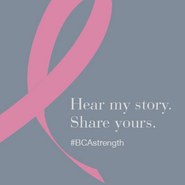
 Estee Lauder's Breast Cancer Awareness campaign
Estee Lauder's Breast Cancer Awareness campaign